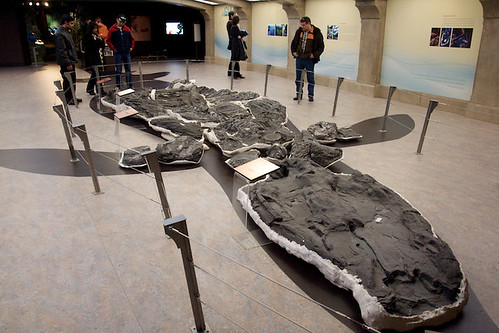 |
| An artists impression of Shonisaurus sikanniensis |
Dr Mark McMenamin of the Mount Holyoke College excavated a series of Shonisaur fossils with his daughter over a few days in summer at the Berlin-Ichthyosaur State Park in Nevada, USA. While this might not sound very exciting, the fossils from this site have baffled many palaeontologists throughout the years. 'Charles Camp (a U.C Berkeley doctor and world expert on the fossil formation) puzzled over these fossils in the 1950s,' said McMenamin. 'In his papers he keeps referring to how peculiar this site is. We agree, it is peculiar.'
The creature that once comprised the bones died in shallow water. Camp suggested that this was due to them being stranded or from poisoning by blooms of toxic algae. The problem with these theories is the way the bones are laid. Rather than being scattered about the sea bed, they are neatly arranged into patterns and geometric forms. Careful analysis shows that the bones are not fakes and that they were laid down in this strange fashion millions of years ago. However geological processes cannot place bones into distinct forms.
What could have happened? Was this a shallow or deep ocean death? 'It became very clear that something very odd was going on there,' said McMenamin. 'It was a very odd configuration of bones. Yet the traces that did exist were distinctive.
 |
| A 'smaller' fossil specimen of Shonisaurus sikanniensis |
Due to the arrangement of the bones, he believes that some kind of giant cephalopod was the killer. Today, giant squid and octupi have been known to prey upon sharks. Shonisaurus sikanniensis was a predator similar in shape to a shark and therefore a predator prey relationship could have formed between the two animals. At first the theory might seem far-fetched, but when the situation is examined more closely, it becomes more plausible.
 |
| The vertebrae which mimic the pattern of suckers on a cephalopod tentacle |
Many complete Shonisaur skeletons display broken ribs and twisted necks. McMenamin suggests that these were caused by the powerful tentacles of a giant undiscovered predator that roamed the Triassic seas. The theory does parallel nicely the sentiment that no matter the size of a predator, there will always be a bigger one. The final piece needed to complete the theory is evidence of such a creature. Unfortunately it is a perfect Triassic crime as Octupi are soft bodied and are not often preserved to any degree. Personally, I hope that such finds will confirm the theory as it would be good to have a palaeontological root for the legend of the mighty kraken.